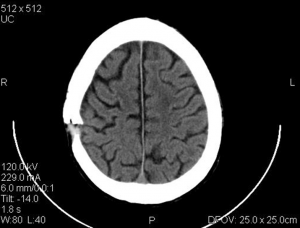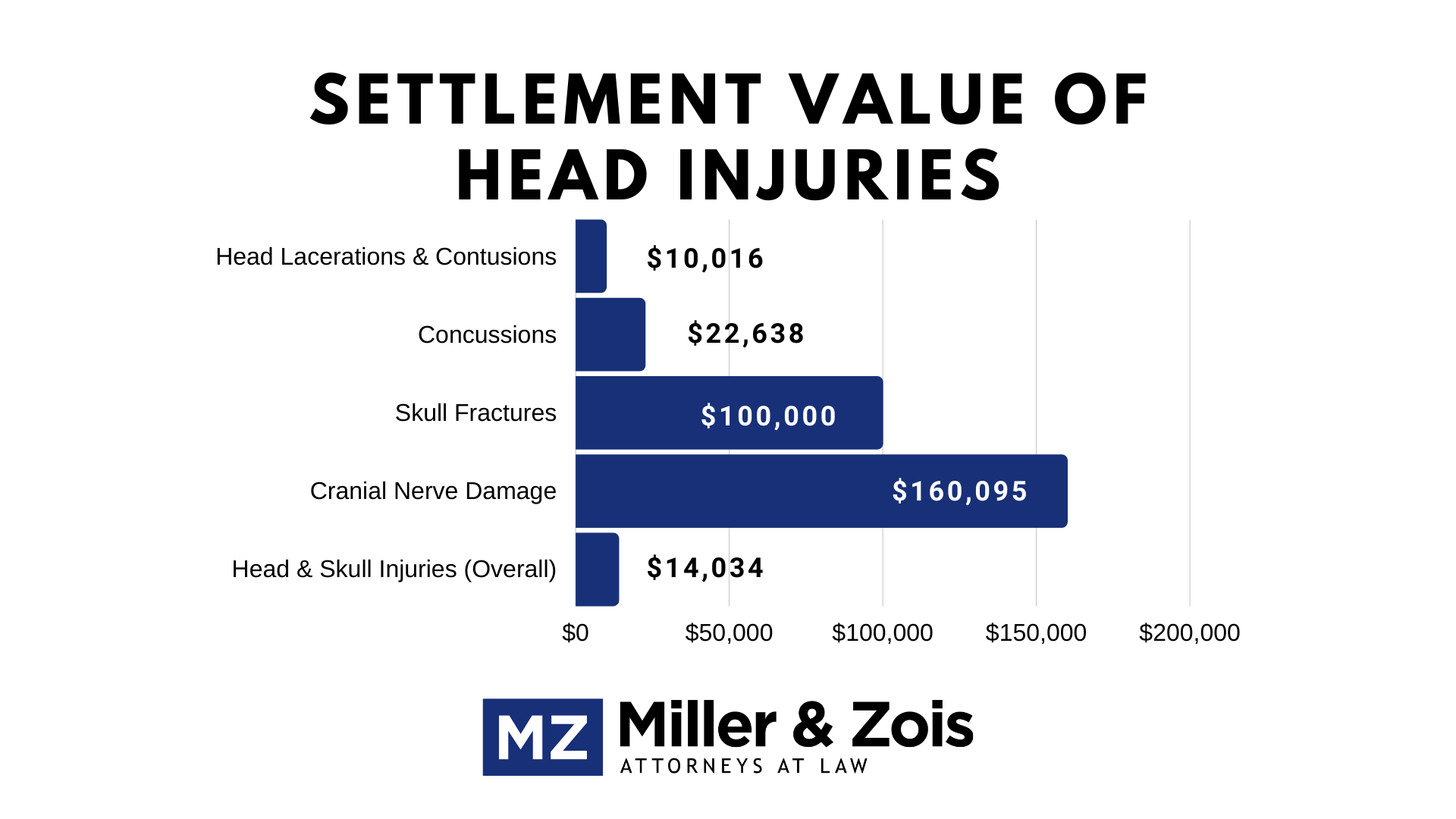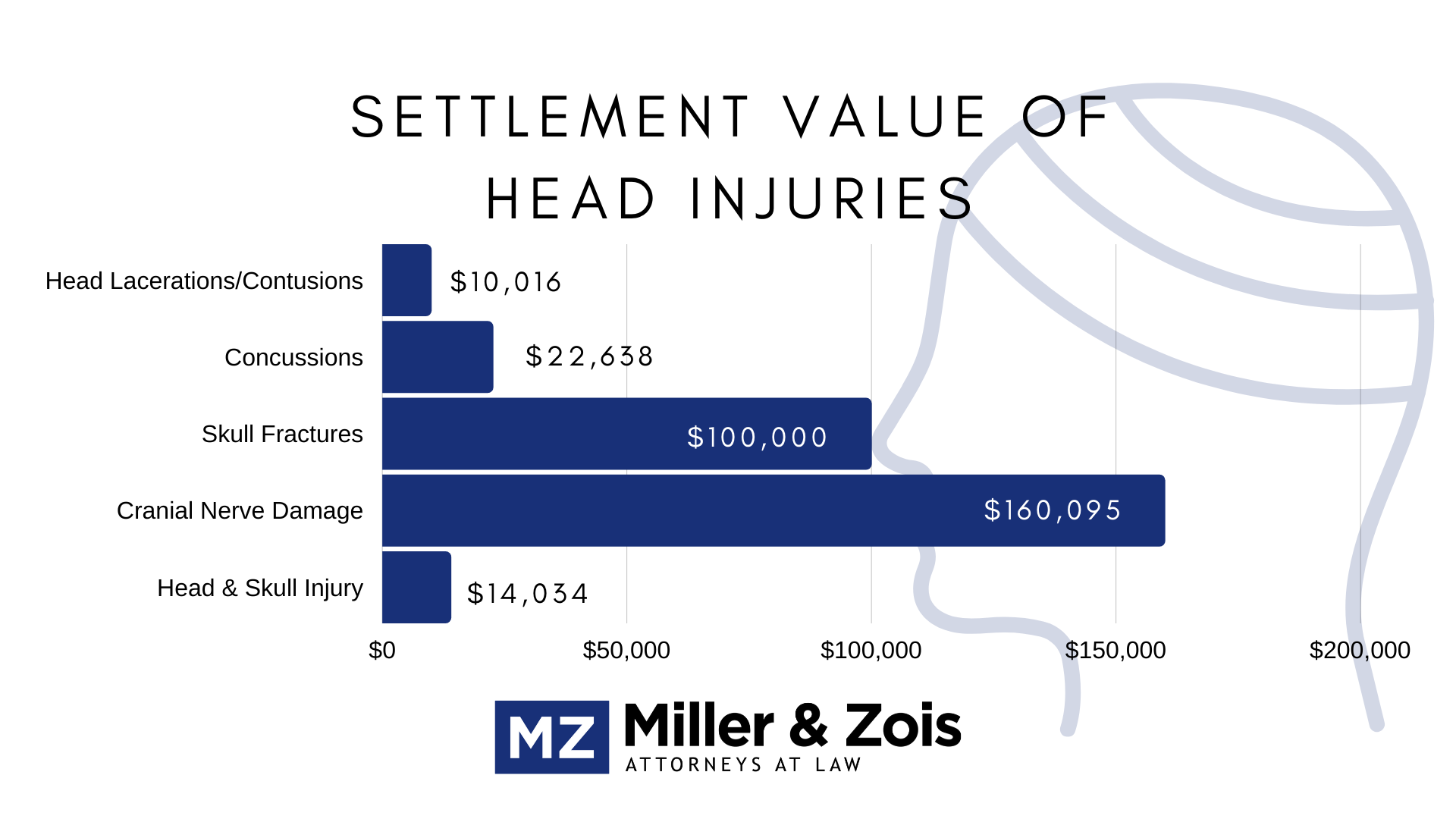This page is about head injuries and their settlement compensation in personal injury lawsuits.
Our lawyers see a lot of head injuries in our practice. Head injuries to automobile occupants have been shown to be a major cause of death and permanent brain injury. We see head injuries that range from headaches that resolve quickly to brain damage that destroys a life.
When it comes to determining appropriate settlement payout, head injuries might be the hardest personal injury claim to evaluate. Head injuries are a common occurrence in personal injury cases and they are often difficult to assess. The head is a complex part of the body with delicate and vital structures. The effects of an injury to these structures may be subtle, slow to appear, and difficult to diagnose. Head injuries can also affect a person’s posture, appearance, and sensory organs, which can have a significant emotional impact on the person suffering the injury.
Head injuries often involve injuries to the brain, which is made up of the cerebrum, brain stem, and cerebellum. While most brain injuries involve primarily the cerebrum, there are instances where injuries affect other portions of the brain. Maddeningly for victims, severe brain injuries can occur even without much visible evidence of the initial blow to the head. This means that a lack of objective evidence of severe trauma is not a reliable indicator of the possibility of brain injury.
Settlement compensation for head injury lawsuits is generally high because the pain and suffering for these cases is often through the roof and medical and therapeutic interventions required for the rehabilitation and recovery of the victim are expensive. These interventions typically involve numerous medical and therapeutic specialists.
Statistics Head Injury Settlement Amounts
The data on head injury verdicts does not make you happy if you are a plaintiff:
- Head Lacerations and Contusions: $10,016
- Concussions: $22,638
- Skull Fractures: $100,000
- Cranial Nerve Damage: $160,095
- Head and Skull Injuries, Overall: $14,034
I can tell you the statistics for our law firm are very different. I can’t imagine taking $22,000 in a concussion case. But these may well be the most misleading statistics I have ever posted on this blog. First, these are median, not average verdict statistics. Almost one-fourth of skull fracture cases result in a verdict over $1 million (which includes skull fractures that cause no actual injury – we have seen those). Yet the median is only $100,000. I don’t know what the average head injury verdict is – I can’t find any statistics – but I’ll bet you the average verdict in a case with a permanent head injury is over $1.5 million.
Types of Personal Injury Claims Involving Head Injuries
Personal injury head injuries can vary in type and severity depending on the circumstances of the accident. Here are some common types of personal injury head injuries:
Concussion: A concussion is the most common head injury we see in motor vehicle accidents. By definition, a concussion is a mild traumatic brain injury that can occur from a blow to the head or a violent shaking of the head. Symptoms may include headache, dizziness, confusion, and memory loss.
Skull fracture: A skull fracture occurs when there is a break in one of the bones that make up the skull. The severity of a skull fracture can range from mild to life-threatening, depending on the location and extent of the fracture.
Contusion: A contusion is a bruise on the brain that can occur from a blow to the head. Symptoms may include headache, dizziness, confusion, and memory loss. A confusion really depends on the severity, some are relatively harmless and some are life-threatening.
Hematoma: A hematoma is a collection of blood outside the blood vessels. In the case of a head injury, a hematoma can occur within the brain tissue or between the brain and the skull. Symptoms may include headache, dizziness, and loss of consciousness. There are various degrees of hematoma. The one that sets off the biggest alarms is a subdural hematoma which occurs when blood accumulates between the brain and its outermost protective layer, called the dura mater.
Diffuse axonal injury: A diffuse axonal injury is a serious brain injury that occurs when there is a widespread shearing and tearing of the brain’s nerve fibers. This can occur from sudden acceleration or deceleration you get in a serious car crash. Symptoms may include coma, severe cognitive impairments, and motor deficits.
Penetrating injury: A penetrating injury occurs when an object enters the brain through the skull, such as a bullet or a piece of shrapnel. The severity of the injury depends on the location of the injury and the size of the object.
Science of Car Crash Head Injuries
Head injuries have been documented as a result of high-energy, rear-end motor vehicle crashes where the head has come into contact with the interior of the vehicle. Plaintiffs’ lawyers have long fought the “high energy” part of that statement, arguing that what happen to egg carton is different from what happens to the eggs inside. This is 100% true. But we cannot pretend that most serious head injuries occur in high impact crashes. That is just a fact.
Two Primary Mechanisms of Injury: Contact and Inertial Loading
The brain can be damaged during these types of crashes due to two main mechanisms: high rotational head accelerations caused by inertial loading, and the transfer of forces to the brain tissues when the head comes into contact with the vehicle interior. Both contact and inertial forces happen when the head is hit during impact. Only inertial forces (acceleration) are present during impulsive high rotational head motions, which occur without the head hitting an object.
Inertial loading occurs when the head is suddenly accelerated or decelerated, causing the brain to move inside the skull. This movement can lead to shearing and stretching of the brain tissues, which can result in injury. In high-energy, rear-end MVCs, the head can be subjected to significant rotational accelerations, which can increase the likelihood of injury.
In addition to inertial loading, head contact with the vehicle interior can also transfer forces directly to the brain tissues. This can happen if the head strikes a hard surface or if the head is restrained by a headrest or seatback. The forces transferred to the brain can cause even greater injury on top of the injury caused by inertial loading.
What Factor Drive Value in Head Injury Cases?
 I talk here about the factors that matter most in personal injury cases. In head injury cases in Maryland, the big variables will be:
I talk here about the factors that matter most in personal injury cases. In head injury cases in Maryland, the big variables will be:
- Liability: If there is no real liability dispute, this will greatly increase the trial and settlement value of your claim.
- Venue: If your case is in Baltimore City or Prince George’s County, it will have high value than anywhere else in Maryland. Not to say that you cannot get an excellent result, for example, on the Eastern Shore where juries are tougher. But it does make the hill a bit steeper.
- Is the Injury Permanent?: This is a big variable. Juries take very seriously what will happen over the rest of the victim’s life. Past pain and suffering is important, but it does not parallel pain that will last forever in the eyes of the jury.
- Age of the Victim: Younger is better.
- Quality Plaintiffs: This matter so much more than even I realize sometimes. A jury has to believe the plaintiff is “worthy” and jurors take a lot of different paths in determining whether the victim is deserving. The biggest single ingredient in this intangible “worthy”: likability.
- Hatable Defendant: You don’t need a hateable defendant to get an excellent result. But it really makes it so much easier.
Head Injury Verdicts and Settlements
The following are examples of head injury verdicts and settlements:
- 2022, Washington: $40,210 Verdict: The plaintiff was fixing his bicycle in a parking lot when the defendant backed his truck into him. Plaintiff was struck in the head and suffered a head injury diagnosed as a subgaleal hemorrhage with a significant headache and memory loss; loss of consciousness.
- 2021, New York: $30,000 Settlement: The suffered a closed head injury, concussion, and left knee injury when the vehicle he was a rear seat passenger in was struck head-on at a high rate of speed by a vehicle that crossed the double yellow line.
- 2020, Washington: $85,575 Verdict: A 50-year-old female who worked as a paralegal, claimed that she was rear-ended by the defendant while at a red light. Plaintiff alleged head injuries including a concussion and post-concussive syndrome. The jury award included $15,000 in medical expenses and $42k in lost wages.
- 2019, Texas: $203,445 Verdict. A woman’s vehicle was struck head-on by a driver who lost control of his vehicle as he was negotiating around a curve. She was brought to the hospital, where staff diagnosed her with a broken collarbone as well as permanent damage to her XI cranial nerve and C-5 disc. Her breast implant was also damaged, which necessitated plastic surgery. The woman and the tortfeasor settled for their policy limits. She then pursued UIM benefits from her carrier, Allstate. They denied her breast implant damage allegation and claimed that her settlement with the tortfeasor was adequate compensation for her fracture and nerve injuries. The jury awarded her $203,445.
- 2019, New York: $120,303 Settlement. A 4-year-old girl was a passenger in a vehicle that was rear-ended. She suffered a skull fracture, a subarachnoid hemorrhage, and a grade 3 concussion. The case settled for $120,303.
- 2019, Florida: $8,281,522 Verdict. This was the damages phase of a trial whose jury found the defendant 10 percent negligent and the plaintiff 90 percent negligent two years before. A 50-something man’s vehicle was struck as he attempted to cross an intersection. He was transported to the hospital, where staff diagnosed him with fractures to his clavicle, shoulder, arms, ribs, wrists, shins, femur, and lumbar. Staff also diagnosed him with pulmonary edema caused by internal bleeding in his lungs. His medical experts also testified that he experienced damage to his sixth cranial nerve. He was rendered legally blind as a result. The man also suffered a traumatic brain injury that affected his speech, memory, and cognition. He was unable to return to his job at Walmart. The jury awarded $8,281,522 in damages. However, the final judgment amounted to $600,000.
- 2019, New York: $50,000 Settlement. A 9-year-old pedestrian was struck by a vehicle as he walked across an intersection. He suffered a right mid-parietal fracture, a brain hemorrhage, a skull fracture, and a scalp laceration. The driver denied liability for the accident. This case settled for $50,000.
- 2018, Washington: $150,000 Settlement. A 38-year-old man collided head-on with a truck that made an improper left turn. He suffered a skull fracture, specifically a temporal bone fracture that resulted in inner ear pressure. The man also suffered soft-tissue injuries to his chest, neck, and shoulder. An ambulance transported him to the hospital at the scene. The hospital staff discharged him shortly after being evaluated. He sought treatment with his primary care physician, an otolaryngologist, an acupuncturist, a chiropractor, a psychiatrist, and a massage therapist. The case settled for $150,000.
Getting a Lawyer for Your Head Injury Claim
My law firm has handled scores of serious head injury cases. Our Baltimore car accident lawyers know the science, the medicine, and how to put these claims in a position to win. If you have a head injury claim in Maryland, call 800-553-8082 or get a free online case review.
Articles of Interest
- Baker, C.E.,et al. (2022). The relationship between road traffic collision dynamics and traumatic brain injury pathology. Brain Communications, 4(2), fcac033. The article examines the relationship between the dynamics of road traffic collisions and traumatic brain injury. The study analyzed over 2000 collisions involving over 5,000 people. It found that higher delta-V (the change in velocity during a collision) increases the risk of moderate-severe brain injury for all road users. Plaintiffs’ lawyers have long pretended that the severity of a crash is not important. But it really is. Pedestrians and cyclists were, not surprisingly, found to be at a higher risk of brain injury than car occupants, even when accounting for delta-V. Wearing a cycle helmet during a collision was found to be protective against brain injury. The study also examined the influence of the direction of delta-V, with car occupants exposed to a higher lateral delta-V component having a greater prevalence of moderate-severe brain injury. The findings make a really interesting finding: collision notification systems could be used to alert emergency services to collisions with a high brain injury risk, enabling quicker activation of the highest level of emergency service response and improving patient outcomes.
- Viano, D.C., et al (2017). Head injuries (TBI) to adults and children in motor vehicle crashes. Traffic Inj Prev, 18(6), 616-622. doi: 10.1080/15389588.2017.1285023. PMID: 28112983. PMCID: PMC6082169. NIHMSID: NIHMS976043. This study looked at how often people get head injuries in car crashes, and how severe they are. The researchers used four different databases to get information on how many people were injured or died in crashes, and how serious their head injuries were. They found that more people were hospitalized with head injuries than the public health data showed, and that there were more deaths with severe head injuries than the death records showed. However, the databases they used had different ways of counting injuries, which makes it hard to compare them directly. The researchers recommend using a more consistent way of counting injuries in the future.
- Second-Impact Syndrome and a Small Subdural Hematoma: An Uncommon Catastrophic Result of Repetitive Head Injury with a Characteristic Imaging Appearance, J Neurotrauma 27:2557-1564 (2010) (trivial trauma after an earlier head injury may sometimes lead to catastrophic brain swelling with even a small subdural hemorrhage).
- Anoxic brain injuries
- The settlement value of concussion cases
 Maryland Injury Law Center
Maryland Injury Law Center



